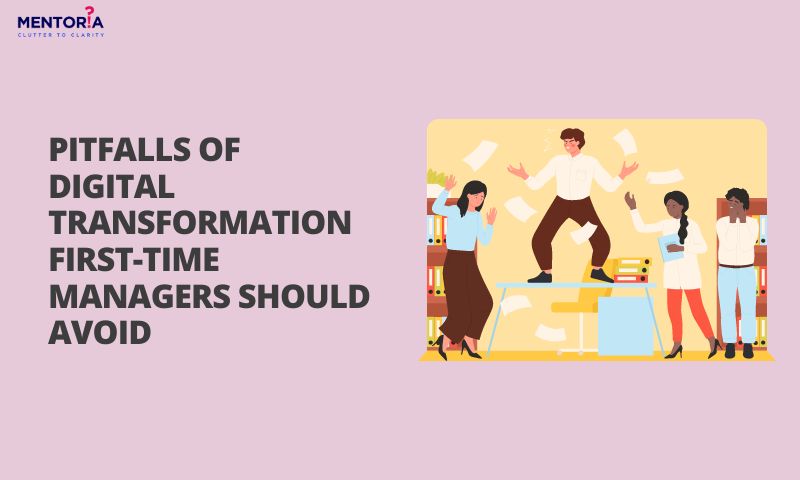Pitfalls of Digital Transformation First-Time Managers Should Avoid

The quest for seamless digital transformation often encounters barriers, with up to 70% of these initiatives ending up hitting roadblocks and missing the mark, according to a BCG research. Now, before you start picturing a tangled mess of wires and servers, let’s unravel these setbacks. It turns out, the blame game is a shared gig between the organisational hurdles and the managers in charge. Whether you’re the face of the company or an employee, the journey of digital evolution comes with its fair share of pitfalls. In this blog, we’ll delve into three prevalent digital traps, shedding light on how to skillfully navigate them. Whether you’re a seasoned professional or a first-time manager, understanding these traps is pivotal to steering your organisation toward successful digital integration.
Traps First-Time Managers Should Avoid
The Digital Curiosity Trap
In today’s fast-paced digital world, there’s a temptation to jump headfirst into the latest tech trends. But hold on – let’s talk about the Digital Curiosity Trap. It’s when new managers rush into using fancy tech without really understanding the problems they’re solving.
So, here’s the deal: before you dive into the world of innovation, take a step back. Ask yourself, does the problem really need a tech solution? Have a chat with your team about the challenges they’re facing and what they’ve tried before. A study in Journal of Information Technology found that a whopping 60% of failed tech makeovers happened because the problems weren’t clear from the get-go.
Now, don’t forget about the data you already have in your organisation – things like performance dashboards and how satisfied your stakeholders are. These are like treasure maps, showing you where you need to improve. Once you’ve got a grip on the real problem, put it in one of three buckets: things humans can fix, stuff that needs tech, or situations that benefit from a mix of both. This way, you’re making smart choices and only using tech where it really makes a difference. Keep it simple, keep it effective!
- Team Collaboration: Encourage open communication within the team to identify pain points and potential solutions collaboratively.
- Root Cause Analysis: Conduct a thorough analysis to understand the underlying causes of the identified issues.
- Holistic Evaluation: Consider both the immediate problem and its broader impact on the workflow before deciding on a digital solution.
- Human-Centric Approach: Prioritise solutions that enhance human efficiency and collaboration rather than merely adopting technology for its novelty.
The Digital Readiness Trap
A digital transformation goes beyond shiny gadgets; it’s about gauging your organisation’s readiness for change. Enter the Digital Readiness Trap – a perilous pitfall for managers misjudging the digital shift. To sidestep disaster, conduct a thorough readiness assessment. Scrutinise your tech infrastructure, team’s digital savvy, and the organisation’s openness to change.
Implementing cutting-edge tech sans a solid foundation spells trouble. Take baby steps – host workshops, training sessions – to boost digital readiness. Identify areas needing extra support for effective tech adoption. Shockingly, 80% of organisations stumbled in digital transformation due to neglecting readiness assessments (Harvard Business Review). Lesson learned: assess tech infrastructure, team literacy, and openness to change upfront.
Foster a culture of continuous learning; empower employees to adapt to digital evolution. Remember, digital transformation isn’t a one-off; it’s a perpetual journey. A gradual, inclusive approach to enhancing digital readiness paves the way for triumphant and sustainable transformations.
- Infrastructure Evaluation: Assess the current state of the technological infrastructure to identify areas needing upgrades or improvements.
- Training Initiatives: Implement training programs to enhance the digital literacy of the team and prepare them for upcoming changes.
- Change Management Strategies: Develop effective change management strategies to ease the transition for the organisation as a whole.
- Leadership Alignment: Ensure alignment from leadership regarding the importance of digital readiness and the steps required for successful transformation.
The Replication Trap
Don’t fall into the Replication Trap! It’s like assuming one-size-fits-all jeans work for everyone – they don’t. Each department in your organisation is a unique snowflake with its quirks and needs.
Avoid the pitfall by being the Sherlock Holmes of digital strategy. Take a deep dive into each department’s world. What works for marketing might need a remix for HR. It’s not about fitting a square peg into a round hole; it’s about customising solutions like a digital fashion designer.
Flexibility is your BFF here. Be the chameleon of digital strategies, adapting to each department’s vibe. Success isn’t about a cookie-cutter approach; it’s about tailoring solutions to dance with the unique beats of every segment. Steer clear of the Replication Trap, and watch your digital strategies groove seamlessly with the diverse rhythm of your organisation.
- Departmental Analysis: Conduct in-depth analyses of each department’s workflows, challenges, and requirements.
- Customisation Strategies: Develop strategies that can be customised to address the specific needs and characteristics of each department.
- Feedback Loops: Establish regular feedback loops to ensure ongoing communication and adaptability to changing departmental needs.
- Pilot Programs: Implement pilot programs in specific departments before organisation-wide deployment to assess efficacy and make necessary adjustments.
The Overspending Abyss
A common misstep for first-time managers is falling into the overspending abyss, fueled by the misconception that more significant investments guarantee better results. Dodge this trap by conducting a cost-benefit analysis before committing to substantial expenditures. Evaluate the long-term value against short-term gains, considering scalability and sustainability. Often, cost-effective solutions can yield remarkable results. Remember, it’s not about the size of the investment but the strategic and judicious use of resources that defines success in digital transformation.
- Cost-Benefit Analysis: Before diving into substantial investments, conduct a thorough cost-benefit analysis. Assess the potential long-term value against short-term gains to ensure a strategic and financially responsible approach.
- Scalability and Sustainability: Consider the scalability and sustainability of proposed solutions. Opt for investments that align with your organisation’s growth trajectory and ensure that the chosen technology can evolve seamlessly with changing needs.
- Cost-Effective Alternatives: Explore cost-effective alternatives that may deliver impactful results. Sometimes, innovative solutions with a leaner price tag can outshine their more expensive counterparts.
- Strategic Resource Allocation: Instead of focusing on the size of the investment, prioritise strategic resource allocation. Direct your financial resources to areas that promise the most significant impact on digital transformation goals.
The Change Management Oversight
Overlooking the human side of digital transformation is a cardinal error. Many first-time managers concentrate solely on technological aspects, neglecting the need for robust change management. To avoid this oversight, prioritise communication, training, and involving team members in the transition. Understand the impact of change on individuals and address concerns proactively. Recognise the value of a well-prepared and motivated team in ensuring the success of digital initiatives. In essence, treating digital transformation as a holistic organisational change, rather than a mere technological update, is vital for long-term success. Research in the Journal of Organisational Change Management showed that 65% of digital transformation failures were linked to neglecting change management aspects. This underscores the significance of focusing on communication, training, and involving team members in the transition for successful digital initiatives.
- Proactive Communication: Prioritise proactive communication to keep your team informed throughout the digital transformation journey. Openly discuss the reasons for the change, its benefits, and address concerns to create a culture of transparency.
- Tailored Training Programs: Develop tailored training programs to enhance digital literacy within your team. Address the specific needs and skill gaps, ensuring that everyone is equipped to embrace the changes seamlessly.
- Team Involvement: Involve team members in the transition process. Solicit feedback, ideas, and concerns, making them feel valued and included in the decision-making process.
- Holistic Organisational Change: View digital transformation as a holistic organisational change. Consider not only the technological aspects but also the impact on workflows, roles, and organisational culture. A comprehensive approach fosters a smoother transition and greater acceptance.
Digital Transformation With Wisdom
As you navigate the digital transformation landscape, remember that success lies not just in technology but in strategic decisions and a profound understanding of your organisation. By sidestepping the common pitfalls – from the allure of overspending to the oversight of change management – you can lead your team towards effective digital integration. Stay agile, adapt to the unique needs of your organisation, and keep the human element at the forefront.
We’re here to provide you with all the help! Kick-start your journey with Mentoria and discover the right fit for you. Dive into Mentoria’s corporate and business workshops and get tailored guidance. We’ve got your back in navigating the twists and turns of the corporate landscape. Give us a ring, chat with our career mentors, and let’s find the perfect plan for you!









